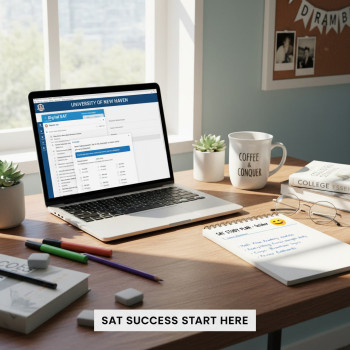The quiet panic after you hit “submit”: welcome to the SAT waiting room
It’s 10:23 p.m., you’ve closed the laptop, and the seat of your chair still remembers the pressure of those last minutes when you guessed on that reading question. You did your best. You walked out. You ate a celebratory slice of pizza. And now you are—what? Waiting. Rewinding the exam in your head. Wondering whether that one tricky math problem cost you twenty points. Refreshing your email every five minutes because, surely, the College Board will send it any second now.
If this sounds familiar, you’re not alone. Waiting for SAT scores is one of those universal teenage rites of passage that confuses logic and emotion in equal measure. Rationally, you know scores take time: the Digital SAT is scored and processed through systems designed to be both fair and secure. Emotionally, though, waiting feels like being suspended between two worlds—past exam stress and future admission possibilities—with nothing solid under your feet.
Why the waiting feels so dramatic
Our brains are wired to amplify uncertainty. Evolutionarily, predictable threats get handled quickly; modern uncertainty—like waiting for a test score tied to your future—triggers a deeper, prolonged stress response. Add the cultural weight we place on tests and college admissions, plus social media’s highlight reels, and the pressure cooker becomes understandable.
Here are the emotional stages many students experience during the wait:
- Adrenaline hangover: In the immediate hours after test day you feel drained, like you just ran a mental marathon.
- Obsessive replay: You play test-day moments on loop, especially the parts you weren’t confident about.
- Catastrophe spiral: The worst-case scenario becomes a movie in your head—every missed question grows into an academic Armageddon.
- Comparative stress: You compare timelines: when did your friend get an email? Who’s already celebrating?
- Relief or recalibration: The actual score arrives and you either breathe a huge sigh of relief or begin planning the next move.
Understanding the timeline: what actually happens after test day
Knowing the practical steps behind score release can calm some of the suspense. After the Digital SAT, answers are processed, scores are calculated, and quality checks are performed before results are posted to student accounts. Typically, scores are released within a few weeks of test day, but the exact timing can vary by administration and whether you took the weekend test or a school-day administration. Colleges then receive the scores and begin whatever internal processing they require. That processing time—between score release and college acknowledgment—adds to the wait.
Typical milestones to watch for
- Official score processing and internal quality checks (days to a couple of weeks).
- Score availability on your student portal (usually 2–4 weeks after test day, depending on the administration).
- Colleges receiving electronic score reports (timing depends on the recipient institution).
Emotional strategies: ways to manage the limbo
Waiting doesn’t have to mean suffering. Here are practical mental and behavioral strategies to help you stay steady while scores are being finalized.
1. Convert waiting time into doing time
The most powerful antidote to anxiety is action. Not action that affects your score (that ship has sailed), but action that improves your readiness for next steps.
- Create a calm, simple plan for the next 30 days—review weak topics, read widely, and schedule a few practice sections.
- Set one non-SAT-related goal: read a novel, start a hobby, or begin volunteering. This rebuilds perspective.
2. Build a reality-check checklist
Write down facts to counter catastrophic thinking. Example checklist items:
- I finished the test and submitted my answers.
- The score range for competitive colleges varies—admissions decisions consider more than one test score.
- I can retake the SAT or send superscores if needed.
3. Control what you can, let go of what you can’t
Micro-manage the small things: create a sleep schedule, plan meals, and limit doom-scrolling. Practice a five-minute breathing exercise when you feel the spiral begin.
4. Reframe the outcome
Try this cognitive shift: scores are information, not identity. They tell you where you are in a specific moment—not who you are as a student or person. An average score today can become a stronger score tomorrow with the right plan.
5. Use social support wisely
Share your feelings with friends or family who genuinely support you. But be cautious on platforms that promote constant comparison. A few encouraging texts are better than scrolling a thread of strangers’ highlights.
Practical checklist while waiting: what to prepare so you’re ready for any result
Whether your score opens the door or nudges you to try again, having a plan reduces panic. Below is a simple table you can use to track options and next steps.
| Possible Score Outcome | Immediate Reaction | Next 7-Day Action Plan |
|---|---|---|
| Score meets or exceeds target | Relief, celebration, and subtle disbelief | Celebrate responsibly, update college list, confirm score sends, and begin application polishing. |
| Score close to target (within ~20 points) | Mixed emotions: hopeful but uncertain | Consider whether to keep or retake the score; review trending subscores (math/reading) and target practice accordingly. |
| Score below target | Disappointment, motivation to improve | Plan a diagnostic review to identify weak areas, schedule retest dates, and consider tutoring or focused study blocks. |
Study-first moves if you decide to retake
Retaking the SAT can feel daunting—but it’s common and strategic. If you decide to go for it, the smartest approach is targeted practice, not just more practice.
- Analyze your score report: pay attention to subscores and question-type feedback.
- Prioritize the areas that offer the fastest returns—for many students that’s select math topics or evidence-based reading strategies.
- Mix full, timed sections with daily focused drills to build both stamina and skill.
- Consider 1-on-1 guidance: a tutor can pinpoint patterns in mistakes and build a personalized plan.
Many students find that a structured, guided approach after a first test—especially one that leverages tailored study plans and expert feedback—leads to stronger gains than solo, unfocused practice. That’s where personalized options like Sparkl’s 1-on-1 tutoring and AI-driven insights can be practical: they help you focus on the precise skills that move the needle rather than repeating the same mistakes.
How to interpret your score report without spiraling
When your score arrives, the most important thing is to read it like a detective, not a judge. The report offers more than a single number; it shows subscores, section performance, and sometimes question-type feedback. These are clues about what to keep doing and what to change.
Quick guide to sections and what they reveal
- Overall score: A snapshot of your performance across the test.
- Section/subscores: They show strengths and weaknesses—use them to target study.
- Timing and stamina indicators: If you did fine conceptually but the score dips late in the test, build endurance with timed sections.
Stories from the waiting room: real student perspectives
Hearing other students’ journeys can normalize the rollercoaster. Imagine three brief, composite stories:
- Maya: She obsessively replays the pop-up reading passage she stumbled over. Her score ended up higher than she expected. She credits steady habits and not letting one section define the whole test.
- Jordan: His math score was lower than hoped. Instead of panicking, he did a diagnostic, focused on two weak topics, and raised his score on the next test by concentrating practice where it mattered most.
- Amira: She used structured tutoring after her first test. The personalized plan helped her close multiple gaps and built confidence that transformed the waiting period into productive momentum.
Practical self-care during score release season
Don’t underestimate the small rituals that keep you centered.
- Maintain sleep: aim for consistent bedtime and wake time.
- Move daily: even a 20-minute walk reduces cortisol and refreshes thinking.
- Eat balanced meals: your brain needs steady fuel to manage stress.
- Limit decisions: simplify routines so your mental energy isn’t drained by small choices.
What parents and mentors can do
For the adults in a young person’s life, the best help often looks like presence and perspective, not problem-solving. A few practical tips:
- Listen more than you lecture—acknowledge feelings before offering solutions.
- Help students map next steps: whether celebrating, retaking, or revising college plans.
- Offer practical support: scheduling, arranging tutoring sessions, or creating a calmer home environment during score season.
When to seek help beyond your own plan
If waiting spirals into persistent anxiety, disrupted sleep, or avoidance, it may be time for extra help. This could be a school counselor, a trusted mentor, or a professional—especially if anxiety affects daily functioning. Academic support can also be scaled up: targeted 1-on-1 tutoring, diagnostic testing, and data-driven study plans often make the difference between repeated effort and efficient improvement.
Concrete timeline and action planner (sample 6-week plan)
Below is a practical six-week plan you can adapt depending on whether you’ve just taken the test or are planning a retake.
| Week | Focus | Sample Actions |
|---|---|---|
| Week 1 (score arrives) | Interpret & decide | Read score report, set a decision meeting with parent/mentor, decide to retake or move forward. |
| Week 2 | Diagnostic & goals | Take a full diagnostic, choose 2–3 target areas, build weekly study blocks (4–6 hours/week). |
| Week 3 | Focused skill work | Daily short drills, one full timed section, review errors and patterns. |
| Week 4 | Strategy & stamina | Practice pacing strategies, simulate test-day timing, strengthen weak topics. |
| Week 5 | Full practice tests | Take two full timed practice tests with review days in between; refine target strategies. |
| Week 6 | Polish & rest | Light review, sleep optimization, test logistics, and mental rehearsal. |
How personalized tutoring changes the waiting experience
When a student decides to retake or simply wants reassurance before a high-stakes submission, tailored support transforms anxiety into a concrete plan. Personalized tutors do more than teach content: they read patterns in your errors, build a schedule that fits your life, and give you accountability that’s compassionate and practical. Services like Sparkl’s personalized tutoring blend expert tutors with AI-driven insights to create targeted study plans, which helps students spend their wait time in productive, confidence-building ways rather than pure worry.
Final thoughts: the waiting room has an exit
Waiting for SAT scores is intense because it sits at the intersection of identity, ambition, and uncertainty. But the waiting is never inert—what you do during it matters. You can choose to let anxiety take the lead, or you can steer the time toward preparation, perspective, and small wins.
No single score defines you. Whether your results delight you or push you to try again, each outcome is data—useful, actionable, and temporary. With practical strategies, social support, and targeted preparation (including 1-on-1 help if you want it), the emotional rollercoaster of waiting can become an engine for growth.
And remember: if you need a partner to turn post-test nerves into a plan of action, personalized help—like 1-on-1 tutoring, tailored study plans, and AI-driven feedback—can make the process clearer and more efficient. The score is a milestone, not the finish line.
Actions to take right now
- If your score isn’t out yet: set a small daily routine that balances study and self-care.
- If your score just arrived: read the report like a detective, not a critic, and make a decision checklist.
- If you’re retaking: choose targeted practice areas, simulate full tests, and consider structured tutoring.
Waiting is uncomfortable, but it doesn’t have to be paralyzing. Treat the pause between test day and score release as a strategic window—one where the right moves matter more than frantic replay. Deep breath. You’ve got this.
Parting note
College admissions and testing are chapters, not final chapters. Scores are useful markers on a longer path. Use them to learn—about your study habits, your strengths, and the strategies that suit you best. When the email arrives, open it with curiosity, not dread. The result is important, but it is never the whole story.















No Comments
Leave a comment Cancel